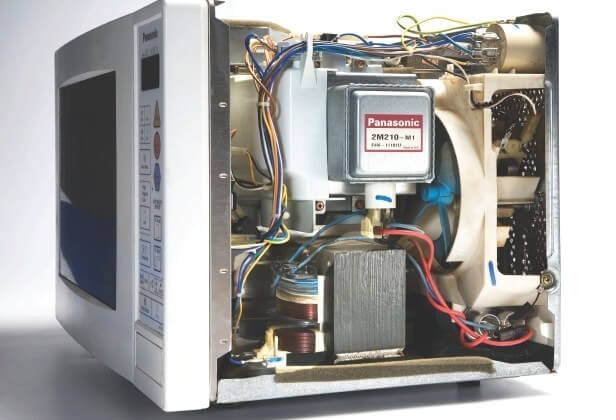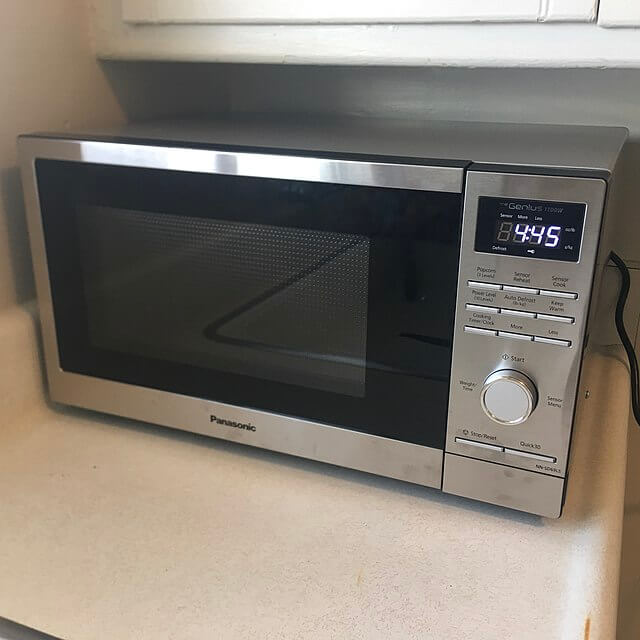Last Updated on August 8, 2023 By Emma W. Thomas
A Microwave Oven usually generally uses MOTs (Microwave Oven Transformer), a very high voltage powerful transformer that typically releases an output voltage of 2kVeff at more than 1000 Watt power. This can be equivalent to an output current of about 0.5Aeff at 2kVeff voltage. If we talk about the current at a short circuit, then that would be even higher.
Microwave Ovens And Their Utility
Since their advent in the early 1980s, Microwave ovens have gradually become ubiquitous in households and kitchens. Almost every modern-day household presently owns one microwave, some even more. But not many of us are concerned about the actual work they put in to provide us with what we need. Their working procedure isn’t really clear to most people using them. Over the last few decades, microwave ovens have become more and more familiar like other household items. Most users still appear to be futuristic gadgets that can cook and warm up food items for us. Well, it’s high time we get to know more about their functionality and how they work. Through this article, we intend to do just that.
What Are Microwave Ovens Entrusted With Doing?
Let us start from the very basics. Although, I doubt there would be anyone unaware of the work of a Microwave Oven. Microwave Ovens are an improvement over conventional ones because they cook the entire food as a whole instead of through convection methods. In conventional ovens, the outer portion of the food initially absorbs the heat and then slowly transfers it to the interiors. Microwave ovens, on the other hand, pass the heat entirely through the food at one go. The primary reason for this is that staying true to its name, microwaves are used to heat food items inside the oven. Microwaves usually pass through all objects except for fats, sugars, and liquids, which convert the microwave into heat and absorb it.

How To Avoid Accidents And Injuries While Using Microwaves?
Almost every other day, the FDA receives reports about fatal skin injuries and burns caused by mishaps associated with microwave oven usage. Microwave Oven accidents are more common than they thought. For instance, superheated water does not actually look to be boiling when heated inside a cup. On such occasions, slight disturbances while transferring the water onto some other cup can cause it to erupt violently and burn the hands and skin of the holder. This can be overcome by adding sugar or coffee, or whatever was intended to mix with it before displacing the cup.
Each and every microwave oven comes with a user manual having important safety precautions that are to be followed while using it. Each dish has a recommended heating time. The user must adhere to it. Sometimes they might have to alter it considering the varying quantities of the cook. Yet they must still be within the permissible range for the particular food item.
Vital Parts Of A Microwave Oven
Before we understand how the Microwave Oven functions, let us go through the basic parts and briefly understand their utility in the entire setup.
1. Magnetron
Magnetrons are essentially large devices that are built in all Microwave Ovens. It consists of two magnets, large and placed at opposite ends of the anode. The anode is basically a cathode surrounded by R.F. fields with a few cavities allowing the passage of electrons. As electricity passes through the magnetron, these electrons are manipulated so as to create microwave radiation, which is then passed to the chamber of the oven.
2. Waveguide
The Waveguide is functionally a metal tube, hollow on its inside through which microwaves can travel to the oven chamber from the magnetron. As the name suggests, waveguides are responsible for properly guiding the microwaves along their intended path and restricting any misdirection of the radiation as well. If the waveguides were to fail or become nonexistent, the microwaves would then travel freely in any direction and hence damage surrounding equipment such as the transformer, the magnetron, and even the operator standing in close proximity to the oven.

3. Oven Chamber
The area where the food is essentially cooked is known as the oven chamber of the microwave oven. It consists primarily of a rotating gear upon which a glass plate is placed. The apparatus spins as the oven operates and cooks the food. The rotation allows even distribution of the heat throughout the food allowing harder food items such as meat and fish to be cooked properly as well. The chamber also includes a light that turns on as the cooking starts and continues till it ends. It provides visibility inside the chamber as the food cooks so that the users can have an idea of how the process is going on. The waveguides open into this chamber, bringing in the microwaves that help provide heat to the food.
4. Transformer
As the microwave operates through the creation of a considerable quantity of radiation of microwaves, it needs a strong power source to provide the same. This could easily shoot the consumer’s electric bills up the chimney. This is overcome by using a transformer. The transformer provided inside the microwave oven steps up the electricity from the power supply to a higher voltage, which is required by the oven. As mentioned before, the average MOT releases around 2kVeff for the oven to operate smoothly. The working of the transformer is essentially to step up the voltage provided by our domestic power source and bring it up to the oven’s voltage rating.

5. High Voltage Control Circuit
The microwave also requires a Control circuit to manipulate the extremely high voltages that the oven operates with. This High voltage control circuit is basically an electronic circuit board that deals with controlling the high voltages associated. The complicated nature of the transformer and the magnetron in such a tight space together can cause the transformer to overload and explode, resulting in fatal accidents and damage to equipment. The control circuit is responsible for preventing such fatalities by disconnecting the transformer from the power source whenever there is a chance of overloading. Hence the chances of an explosion are negated and dealt with by this circuit.
6. The Power Source
Last but never least, our domestic power supply is the mandatory aspect that provides the 120 V of A.C. that the oven requires to operate. Large domestic appliances such as blenders and refrigerators use this standard electricity amount for functioning. Microwave ovens, on the other hand, are too bulky and large and hence use a semi-permanent power outlet for power supply. That is why portable Microwave Ovens need to be operated by virtue of a battery. Many other concepts are being worked upon presently regarding a suitable power source for a Microwave Oven.
Functions Of The Different Parts Of The Microwave Oven
| Parts Of The Microwave Oven | Functions |
| Magnetron | Creates microwave radiation |
| Waveguides | Guides the microwaves to the oven chamber |
| Oven chamberTransformer | The food is kept and cooked here. Steps up the domestic power supply to match the rating of the oven |
| A high voltage control circuit | Manipulates the transformer and prevents overloading |
How Is It Cooked?
- The electron tube inside the Microwave Oven named the magnetron produces a magnetron continuously as it is switched On.
- These waves get reflected through the oven interiors and are brought into the oven chamber through the Waveguides.
- These microwaves can pass through all objects, especially oven-friendly containers. Hence they reach the food items easily, bypassing the containers they provided in.
- As they come across fat, starch, and liquid items, they disintegrate and release heat into them, and make them cooked.
- When thicker foods are cooked, their outer layer is heated first, and then the heat is passed on to the inside.
- The food is entirely cooked in one go and in a short amount of time. This preserves most of the nutritional value of the food.
- The most common containers used in microwave ovens are plastic, ceramic, glass, and paper as the microwaves pass through these materials. Although very thin plastic must be avoided as it can melt from the heat of the food being cooked.
- Metals and aluminum are avoided as well as microwaves are reflected off their surfaces, causing uneven heat dispersion and possible damage to the oven chamber.

How much voltage does a microwave transformer draw?
Transformers are devices that convert one form of electricity to another, and transformers built for microwaves convert 120 volts (V) of alternating current (AC) to 2,450 V of high-voltage direct current (DC).
What are the different types of transformers?
There are two main types of transformers: induction and step-down. Induction transformers convert high-voltage to low-voltage. Step-down transformers allow the voltage to be lower than it is originally. Transformers come in various shapes and sizes and can be found in many places like power plants, substations, and homes!
How many volts does a transformer need to produce?
They can be distinguished by the type of work they do, their construction, and the frequency of the power they supply. There are three basic types of transformers: power transformers, transmission line transformers, and unit substation transformers. Power transformers are used in homes or businesses to convert electricity from a higher voltage to a lower voltage.
Conclusion
Microwave Oven transformers or MOTs are essentially high-voltage transformers that manipulate the voltage supplied to them from the power source and bring it within the voltage rating of the oven. The oven requires the transformer, the waveguides, the magnetron, and a few other parts to function properly. Users must conform to the safety guidelines and stick to the permissible time limit for each dish while cooking them using the microwave oven.
References:
https://www.maytag.com/blog/kitchen/parts-of-a-microwave.html
https://www.quora.com/How-many-volts-does-the-output-of-a-transformer-of-a-microwave-oven-have
Emma is a graduate of Domestic Science or Family and Consumer Sciences (Home Economics) from the University of Wisconsin. She has 7 years of experience Working with the strategic section of BestBuy and now writing full-time for Homeeon.
From Managing the Home, Interiors, Cleaning, and Exteriors to Gardening and everything about Making A Home Liveable – is her passion and this Homeeon is the result of this.
Emma loves decorating her home with the best stuff found online. She cares about quality over anything and writes reviews about them here in Homeeon. Get in touch with her over Pinterest.
Keep reading her blogs.
